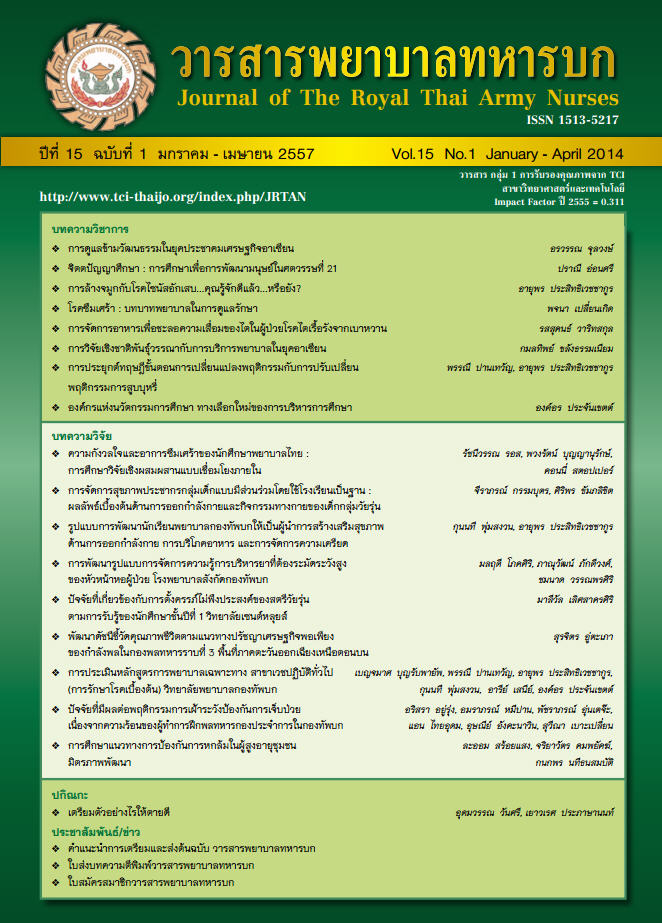Worries and Depressive Symptoms among Baccalaureate Nursing Students in Thailand: An embedded Mixed Methods Study ความกังวลใจและอาการซึมเศร้าของนักศึกษาพยาบาลไทย : การศึกษาวิจัยเชิงผสมผสานแบบเชื่อมโยงภายใน
Keywords:
Worries, Depressive symptoms, Baccalaureate Nursing Students, ความกังวลใจ, อาการซึมเศร้า, นักศึกษาพยาบาลระดับปริญญาตรีAbstract
This embedded mixed methods study examined and described worries and their association with depressive symptoms among baccalaureate nursing students in Thailand. Both quantitative and qualitative data were collected simultaneously in July 2007. While quantitative data were used to examine the associations between worries and depressive symptoms, qualitative data were used to describe in-depth the associations between these two concepts.
One hundred and twelve junior and senior nursing students were drawn from a larger study of depressive symptoms and their predictors among nursing students in four countries (Japan, Taiwan, Thailand, and the USA). Out of 112 students, 86 reported at least one worry, with a total of 282 worries reported. Six fields of life worries were generated from participants’ narratives. These fields include school and time management, health, interpersonal relationships, economic concerns, national board examination, and professional concerns. Hierarchical regression showed that worries were positively associated with depressive symptoms (β= .377) and accounted for 13.6% of the explained variance in depressive symptoms. To cross-validate the quantitative findings of a significant positive relationship between worries and depressive symptoms in this study, a case exemplar is presented to provide in-depth information about the phenomenon. Content analysis was performed to examine coping strategies, or what had helped some students to have a positive outlook towards life. Several students described available resources (especially emotional support from family and friends), practical strategies, and active coping strategies they had used to help them feel good and/or to cope with their worries. Nursing implications are discussed.
การวิจัยนี้เป็นการศึกษาเชิงผสมผสานแบบเชื่อมโยงภายในด้วยการตรวจสอบและอธิบายความกังวลใจและความเกี่ยวโยงกับอาการซึมเศร้าของนักศึกษาพยาบาลระดับปริญญาตรีในประเทศไทย โดยได้เก็บข้อมูลเชิงคุณภาพและเชิงปริมาณไปพร้อมกันในเดือนกรกฎาคม 2550 ข้อมูลเชิงปริมาณได้นำมาใช้ในการตรวจสอบความเกี่ยวพันระหว่างความกังวลใจและอาการซึมเศร้า ส่วนข้อมูลเชิงคุณภาพได้ใช้ในการอธิบายเชิงลึกในเรื่องความเกี่ยวพันของสองแนวคิดข้างต้น
นักศึกษาพยาบาล ชั้นปีที่ 3 และ 4 จำนวน 112 คน เป็นกลุ่มตัวอย่างที่นำมาจากกลุ่มตัวอย่างของการวิจัยใหญ่ในเรื่องอาการซึมเศร้าและการทำนายกลุ่มนักศึกษาพยาบาลจาก 4 ประเทศ (ญี่ปุ่น ไต้หวัน ประเทศไทย และสหรัฐอเมริกา) ในจำนวนนักศึกษา 112 คน จำนวน 86 คน รายงานถึงความกังวลใจอย่างน้อย 1 เรื่อง จากจำนวนรายงานทั้งหมด 282 เรื่อง จากความกังวลใจใน 6 ประเด็น ได้มาจากการบรรยายของกลุ่มตัวอย่าง ประเด็นทั้ง 6 นี้ ประกอบด้วย การจัดการด้านการศึกษาและเวลา สุขภาพ
ความสัมพันธ์ระหว่างบุคคล เศรษฐกิจ การสอบขึ้นทะเบียนประกอบวิชาชีพการพยาบาลและการผดุงครรภ์ และความห่วงใยในความเป็นวิชาชีพ การวิเคราะห์การถดถอยแบบมีขั้นตอนแสดงได้ว่า ความกังวลใจมีความสัมพันธ์ทางบวกกับอาการซึมเศร้า (β = .377) และมีอำนาจการทำนายอาการซึมเศร้าได้ 13.6%
ผลการวิจัยข้างต้นได้รับการยืนยันด้วยข้อมูลเชิงคุณภาพ จากกรณีตัวอย่าง ใช้การวิเคราะห์เนื้อหาเพื่อศึกษากลยุทธ์การ เผชิญปัญหาที่ช่วยให้นักศึกษาบางคนจัดการกับชีวิตตนเองทางบวกได้ นักศึกษาพยาบาลบางส่วนได้บรรยายถึงทรัพยากรสนับสนุน (แรงสนับสนุนทางอารมณ์จากครอบครัวและเพื่อน) กลยุทธ์เชิงการปฏิบัติ และกลยุทธ์ในการเผชิญอย่างแข็งขันที่ตนเองใช้แล้วรู้สึก ว่าดี และ/หรือ ช่วยในการเผชิญปัญหาความกังวลใจ ได้อภิปรายถึงการนำผลการวิจัยไปใช้ในบทความด้วย
Downloads
Downloads
How to Cite
Issue
Section
License
บทความหรือข้อคิดเห็นใดใดที่ปรากฏในวารสารพยาบาลทหารบกเป็นวรรณกรรมของผู้เขียน ซึ่งบรรณาธิการหรือสมาคมพยาบาลทหารบก ไม่จำเป็นต้องเห็นด้วย
บทความที่ได้รับการตีพิมพ์เป็นลิขสิทธิ์ของวารสารพยาบาลทหารบก
The ideas and opinions expressed in the Journal of The Royal Thai Army Nurses are those of the authors and not necessarily those
of the editor or Royal Thai Army Nurses Association.






